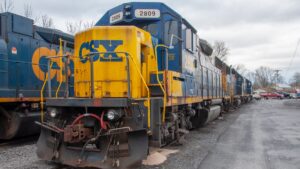CSX’s Fourth Quarter: Revenue and Profit Decline Amid Challenges
In the fourth quarter of 2023, CSX Corporation (NYSE: CSX) experienced a decline in both revenue and profits, highlighting ongoing challenges in the rail transportation sector. While growth in merchandise and intermodal traffic provided some bright spots, they were not sufficient to offset the sharp drops in coal and fuel surcharge revenues.
The impact of severe weather events, including two hurricanes that adversely affected traffic to and from Florida—CSX’s busiest state—also weighed heavily on the company’s performance, leading to disruptions in operations and service metrics.
Company Response and Future Vision
Despite the challenging quarter, CSX’s CEO, Joe Hinrichs, expressed optimism during the earnings call with analysts and investors. He stated, “Overall, we executed well through a difficult period. However, we are not satisfied with these results.” Hinrichs emphasized the company’s commitment to a clear vision that benefits customers, employees, and shareholders alike.
The company reported a 16% decline in operating income for the fourth quarter, which included a $108 million goodwill impairment charge resulting from its Quality Carriers chemical trucking company. When excluding this charge, the operating income was down by 8%. Overall revenue fell to $3.53 billion, marking a 4% decrease, while earnings per share dropped by 16% to 38 cents.
The operating ratio, which reflects operating expenses as a percentage of revenue, climbed to 68.7 for the quarter, up 4.4 points from the previous year.
Looking Ahead: Growth Ambitions and Challenges
Moving forward, CSX is maintaining its three-year growth outlook established during the investor day held in November. However, executives have cautioned stakeholders to expect approximately $350 million in headwinds during the year due to reduced export coal and fuel surcharge revenues, primarily impacting the first half of 2024.
Additionally, CSX anticipates incurring $10 million in higher monthly operating costs connected to the construction of the Howard Street Tunnel clearance project in Baltimore and the ongoing rebuilding of the Blue Ridge Subdivision. The Howard Street project is anticipated to allow double-stack intermodal trains to travel through the Mid-Atlantic for the first time, with completion slated for the end of 2024.
The Blue Ridge Subdivision has also faced significant setbacks, suffering $400 million in damages from Hurricane Helene. As reconstruction occurs, traffic rerouting has led to increased out-of-route miles and additional crew costs.
Despite these obstacles, overall volume for CSX in the fourth quarter rose by 2%, propelled by a 4% increase in intermodal volume. Merchandise volume remained flat, while coal traffic experienced a 7% decline.
To combat these challenges, CSX expects a growth forecast of 3% to 6% for the year, driven primarily by intermodal and merchandise traffic. The company is also shifting its focus toward domestic intermodal growth by converting highway freight to rail and developing a new Southeast-Mexico corridor through a collaboration with Canadian Pacific Kansas City.
Operational Performance under Adverse Conditions
CSX’s operational metrics were significantly affected by the hurricanes, with intermodal trip compliance dropping to 84.9%, down from 94.7% during the same period last year. In addition, carload trip plan performance fell to 75.5% from 84.7%.
Despite environmental challenges, Chief Operating Officer Mike Cory highlighted the company’s strive toward operational efficiency, noting improvements in fuel efficiency and locomotive productivity. Average train speed remained stable, but dwell time increased by 17% as trains were held back due to storm impacts.
During the year, CSX was able to improve its train accident rate by 1%, although the personal injury rate rose by 27%. However, the overall number of employee days lost due to injury reached an all-time low, reflecting a reduction in injury severity.
Financial Overview
For the full year, CSX reported a 5% decline in operating income, totaling $5.25 billion, while revenue slightly decreased by 1% to $14.5 billion. The operating ratio for the year was recorded at 63.9%, marking a 1.4-point uptick compared to 2022.
As CSX navigates through both setbacks and growth opportunities in the coming year, their commitment to strategic infrastructure projects, operational efficiency, and market adaptability will be crucial for sustaining long-term investor confidence.
Join the Conversation
For more insights on transportation sector performance and how companies are adapting to market demands, be sure to follow our updates!
Related Coverage:
- Union Pacific profit up 7% in Q4, forecasts similar growth in 2025
- Fuchs to lead Surface Transportation Board
- Union Pacific official tells shippers of plans for online, security improvements


